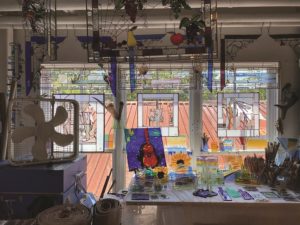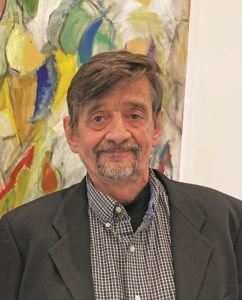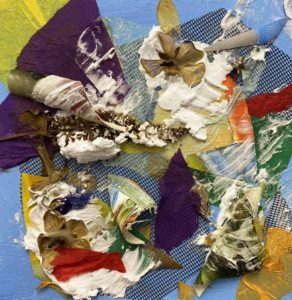Years ago — before the 1998 fire that swallowed the Provincetown Theatre’s original structure, known then and now as Whaler’s Wharf — glassworker Christie Andresen lived in a different Provincetown.
“Nobody was considered a famous artist,” she remembers. “You spent a lot of time with artists without knowing they were artists because they were family people.
“I grew up in Whaler’s Wharf,” she continues. When she was a young teenager, a friend had a store there where she spent a lot of time. Jeweler Dale Elmer had purchased the building in 1973 with his partner, Buzz Buffington. Today, Andresen rents a studio on the second floor where she has been making and selling her stained-glass art for about nine years.
“Dale opened up Whaler’s Wharf to be a place where, as a craftsman, you could come in and rent a small space — but you had to make everything you sold,” says Andresen. “It was really a free-for-all for visual expression.”

Andresen says Elmer taught craftsmen who rented from him to “do it in full.” She recalls him saying, “Make a mess, make noise. Explain your process to customers, because they are not going to be able to find this anywhere else.”
“Working spaces for artists have been a priority at Whaler’s Wharf from the beginning,” says Ben deRuyter, now the managing partner of the Whaler’s Wharf building, which was rebuilt in 2000. “We strive to keep studio rents affordable. Rents on the second- and third-floor studio spaces have increased $210 per month during the 21 years that the building has been open.”
“Provincetown is a very artistic and entrepreneurial community. Always has been,” says Patrick Patrick, CEO of Shank Painter Associates, which owns Marine Specialties on Commercial Street and rents out 14 studios in a warehouse at 207 Route 6. “We have this great history of being a leading art colony, if not the leading art colony in the United States,” he says.
Maintaining a community of “individualistic, independent, creative-minded people, whether they’re artists, fishermen, or small business owners, is important in keeping Provincetown an interesting and unusual place,” Patrick adds.
“It’s as rare as hen’s teeth,” says artist Bill Evaul if you ask about inexpensive studio space on the Cape. Evaul has been renting a studio on Old Ann Page Way for 10 years. Affordable housing developer Ted Malone pioneered the project, which includes 18 dwellings and 10 studios. Malone’s Community Housing Resource Inc. completed construction in 2003.
Having a separate studio is important because many artists don’t have enough space to work in their homes. Small studios, however, also pose challenges. Evaul, for instance, keeps his printmaking press in a friend’s studio that is larger than his own. He also does large-scale paintings, a challenge in a cramped space.
Evaul says artists often find spaces through word of mouth — they go almost as quickly as news of a vacancy travels. “I’m always on the lookout,” he adds. “It’s just the most difficult thing in the world. You know, residential stuff is hard enough. Every little space that might have been a good studio has turned into a mini-apartment.”
Evaul wouldn’t say what he pays in rent for his studio but allowed that “it’s very expensive. For that much money you could get a really nice apartment in Ohio.”
In recent years, a few more reasonable spaces for artists have emerged. After securing a 99-year lease from the town in 2017, the Commons opened in 2019 at 46 Bradford St. at the site of the former Governor Bradford School. It has space for 10 artists to work on-site, and one additional space dedicated to the Generations Project, a New York City-based nonprofit working to compile oral histories of the LGBTQ community.

“Spaces go for $350 a month,” says Commons Executive Director Jill Stauffer, “but if someone can’t afford that, we will certainly have a conversation on what their budget will cover. We do subsidize artists.”
The Commons also limits renters to two renewals of their leases, which can be for three months, six months, or a year, “whatever period of time you need to get your body of work done,” says Stauffer. This renewal limit means that, even though the Commons is at capacity, people can still apply to rent space in the future. Currently, 11 are on the waiting list. “We wanted to give other people chances,” says Stauffer.
One thing that sets the Commons apart is its coworking program. Members pay $100 a month for access to a communal, 1,000-square-foot workspace with 19 stations and 10 additional seating spaces. There are also three meeting rooms, a phone booth, printer, and lounge.
According to Stauffer, “We’ve gotten some really great feedback from the artists on having the coworking people be in the space, because they’ll pop up and say hello, give feedback or a critique — or buy something.”





